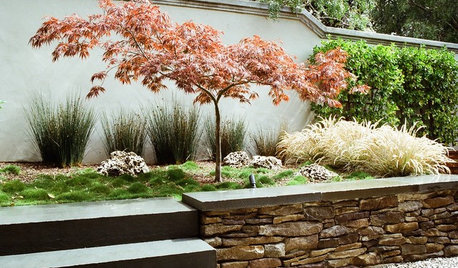growing japanese maples questions
Jetski78
9 years ago
Related Stories

TREES11 Japanese Maples for Breathtaking Color and Form
With such a wide range to choose from, there’s a beautiful Japanese maple to suit almost any setting
Full Story
GARDENING GUIDES12 Japanese Maples for a Sunny Garden
The right maple in the right place shines in hot summer sun
Full Story
GARDENING GUIDES13 Japanese Maples for Shade
A surprising variety of these understory trees is waiting to make a statement in your shade garden
Full Story
GARDENING AND LANDSCAPINGGreat Design Tree: Japanese Maple
Lacy form and fiery fall color make Japanese maple a welcome tree for garden or patio
Full Story
TREESGreat Design Plant: Coral Bark Japanese Maple, a Winter Standout
Go for garden gusto during the chilly season with the fiery red stems of this unusual Japanese maple
Full Story
Design Dilemmas: 5 Questions for Houzzers!
Post Ideas for Landscaping for a Modern Home, Updating a Rental and More
Full Story
KITCHEN DESIGN9 Questions to Ask When Planning a Kitchen Pantry
Avoid blunders and get the storage space and layout you need by asking these questions before you begin
Full Story
ORGANIZINGPre-Storage Checklist: 10 Questions to Ask Yourself Before You Store
Wait, stop. Do you really need to keep that item you’re about to put into storage?
Full Story
FEEL-GOOD HOMEThe Question That Can Make You Love Your Home More
Change your relationship with your house for the better by focusing on the answer to something designers often ask
Full Story
EDIBLE GARDENSSummer Crops: How to Grow Tomatoes
Plant tomato seedlings in spring for one of the best tastes of summer, fresh from your backyard
Full Story





tapla (mid-Michigan, USDA z5b-6a)
Jetski78Original Author
Related Professionals
Saint Louis Park Landscape Architects & Landscape Designers · Bedford Heights Landscape Contractors · Brookfield Landscape Contractors · Columbine Landscape Contractors · Hendersonville Landscape Contractors · Lewisville Landscape Contractors · The Woodlands Landscape Contractors · Vancouver Landscape Contractors · Compton Fence Contractors · Eagle Mountain Fence Contractors · Eastvale Fence Contractors · Oakland Fence Contractors · Saint Louis Park Fence Contractors · Statesville Fence Contractors · La Verne Fence Contractorstapla (mid-Michigan, USDA z5b-6a)
Jetski78Original Author
tapla (mid-Michigan, USDA z5b-6a)